#torah curtain
Text

Torah Ark curtain from Italy, 1717
This tour-de-force of needlework is a unique example of a Torah ark curtain embroidered with the entirety of the text of the Ten Commandments as they appear in Exodus 20. The Hebrew verses are gracefully embroidered onto the silk ground and are spaced according to the traditional layout of the text in a Torah scroll.
Many synagogues have the custom to hang curtains specific to each of the seasons or Jewish holidays, and this curtain was likely hung in front of the Torah ark on Shavuot, the holiday that commemorates the giving of the Torah on Mount Sinai.
A cartouche beneath each of the three columns contains the following enigmatic inscription: “I will reveal my secret to the One Who supports those who run [toward God], for behold my oath is fulfilled.” The initial letters of each of these words are marked and, taken together, spell out the name of the woman who created this extraordinary textile: Esther Kohenet. The name Kohenet indicates that she was the daughter of a kohen; it was a title used by women of this station in eighteenth-century Italy.
255 notes
·
View notes
Photo
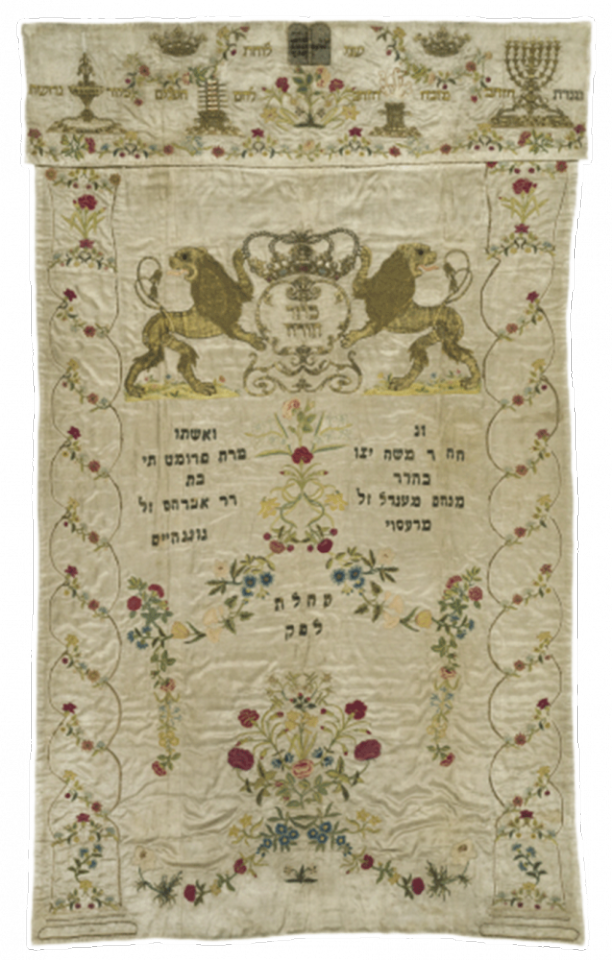
0 notes
Text

Torah ark curtain, Piatra-Neamţ, eastern Romania, 1901
2K notes
·
View notes
Text


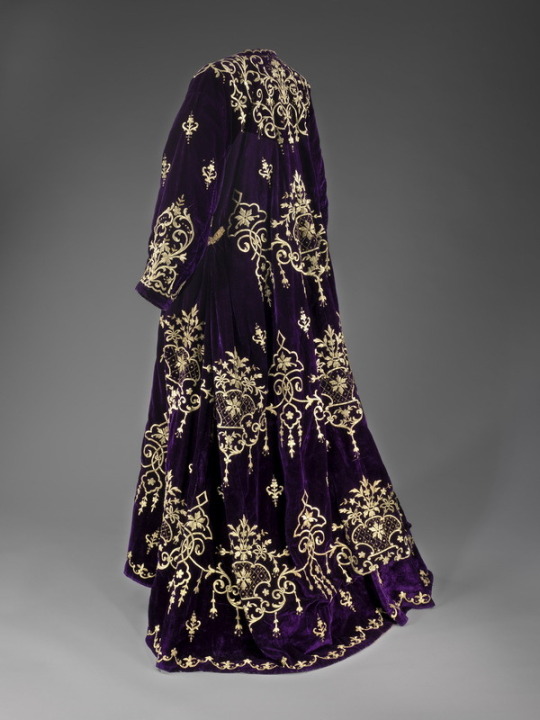
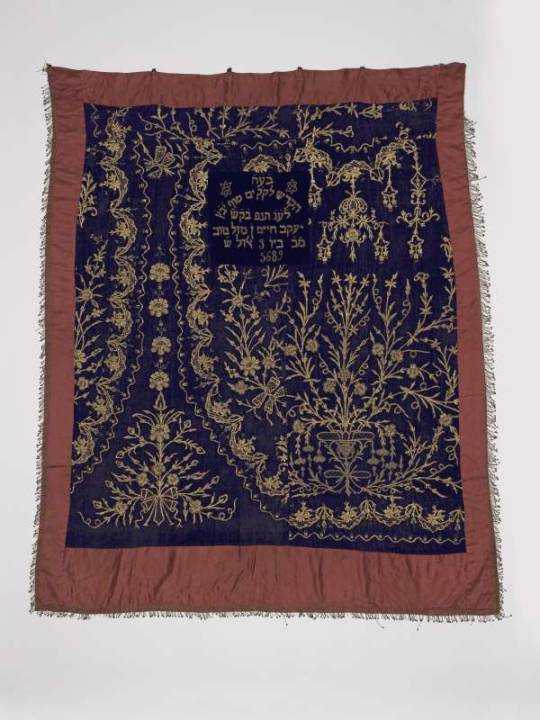
From right to left: Beya Melamed; Bulgaria, 1890 - Jewish bride after the wedding; Turkey, early 20th century - Torah ark curtain made from a woman’s dress; Izmir, Turkey, 1929 - Wedding dress belonging to a Jewish family from Edirne, Turkey; early 20th century, gifted to museum exhibition in memory of Colombe Papo
Worn in the 19th and 20th century for weddings and other occasions by women across the Balkans and Anatolia, bindallı dresses were typically made of velvet in deep jewel tones. They were decorated with extensive gold embroidery of floral designs, which give this group of dresses their name, meaning thousand branches. This Ottoman-derived yet European-influenced style marked a transitional period between uses of traditional and modern western fashions.
The dresses - adopted from the surrounding culture as a fashionable item without any Jewish specificity - took on unique Jewish meaning through their use in the synagogue, where they became ark curtains, Torah mantles and binders, bimah covers, and the like, frequently with added dedicatory inscription. The donation of dresses and trousseau items by women to the synagogues created a personal bond between the women and the synagogue. The habit of donating these textiles to the synagogue endured long after the original embroidered bedclothes and dresses had gone out of fashion, and the transitional bindallı fashion thus remained alive in Sephardi synagogues long after the passing of the brides who wore the dresses.
#jumblr#jewish#jewish history#jewish culture#sephardic history#sephardic culture#this makes me so emotional tbh - the personal bond between the woman and the synagogue; the way they're kept alive through it;#the way we make our surroundings uniquely and specifically jewishly meaningful. no matter where we are or what it is#I unfortunately couldn't find a name for the bride on the top left which is upsetting bc#I think it's important to provide names whenever you can find them with this sort of thing. I've provided all the details I can find#I'd like to do a regular post like this focusing on culture + contributions + connections + etc of jewish women#and sephardic women specifically because we need more of it#my posts
425 notes
·
View notes
Text
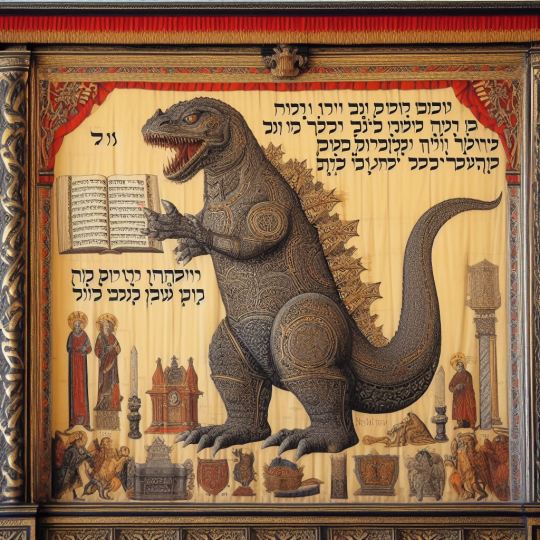
Medieval Torah ark curtain featuring Godzilla
307 notes
·
View notes
Note
hi spring! i'm writing an orthodox jewish character and had a few questions for you.
how does a synagogue work? as in. what does a service look like, and is it possible to visit a synagogue outside of set "service" hours? is the rabbi available for discussion etc outside of those hours?
my character's dad died when he was very young, so his (jewish) mother would take him to the synagogue. would he have to sit on the male side of the synagogue as a child? or would that start after his bar mitzvah?
thank you so much!
Thank you for trusting me with these questions!
Now, a large portion of these questions might be highly dependent on where the characters live, since Israeli shuls tend to be rather different than ones in America, but I'll answer what I know and tag some other people here to offer a more diasporic perspective.
So, Orthodox Jewish prayer service happens three times a day. Morning, afternoon, and night. The morning service is the longest of the three in general, and the special additional Shabbat service is generally hooked on to the end of the morning service, making it quite long depending on the length of the Torah portion that week and how fluently the members of the shul speak Hebrew.
A service will generally be entirely in Hebrew with snippets of Aramaic, though there are places in between the prayers (mainly Shabbat night and morning) where people will sometimes stop and give a dvar Torah, which will usually be in the local language. Shabbat morning service in Israel can be as fast as an hour and a half and I've heard tell of diaspora services that take three or four hours. The length also depends on how much singing you do, and this is a different type of singing than you'd see in a Christian house of worship- we prefer to avoid choirs in our worship (I think it stinks too much of Christianity) and so singing is generally all melodic, involving everyone in the shul.
Whether you can visit a shul outside of service hours depends on the shul. Most community shuls will be locked up, but there are shuls meant to service workers in various jobs, and those will often remain open all day. The rabbi should be available outside of prayer hours for questions and advice, since as the Jewish law expert, that's what he's there for.
Specific people acting as a paid cantor isn't something I've experienced in Israel, since most people are somewhat fluent in Hebrew and the position of cantor will get passed around from week to week, but I've heard it's a thing outside of here.
Children do not have to sit on the appropriate side of the mechitza until they come of age (13 for boys, 12 for girls) but most communities will prefer having them start around the age of 10, with exceptions made depending on the situation. Depending on the style of mechitza, your character could still sit next to his mother then- if they're mobile wooden barriers or curtains, then there will be seating either side of them, and your character and his mother could sit next to each other either side of the mechitza. If the women's section is an elevated section accessed separately, then that's rough on the kid, but the mom might ask a friend to help him get used to it.
Tagging @slyandthefamilybook @daughterofstories @resplendent-ragamuffin @theskyvoid for more specific diasporic stuff.
#jumblr#orthodox judaism#modern orthodox#orthodox jews#writing advice#feel free to join in on the advice becaude i do not know everything
76 notes
·
View notes
Text

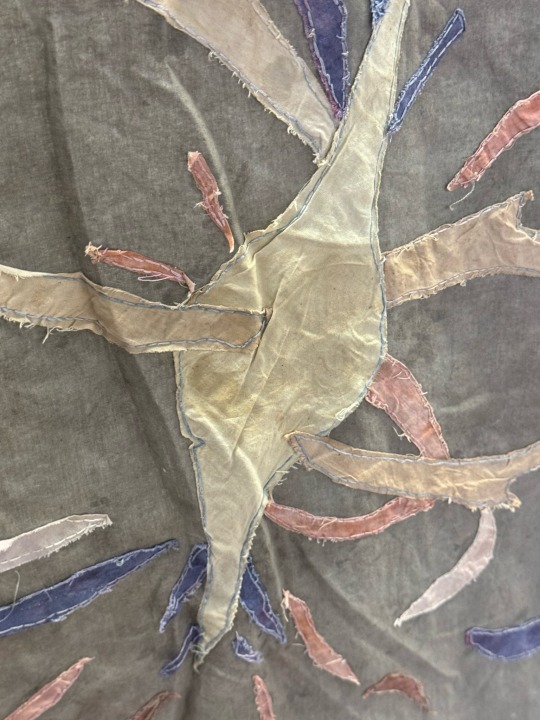
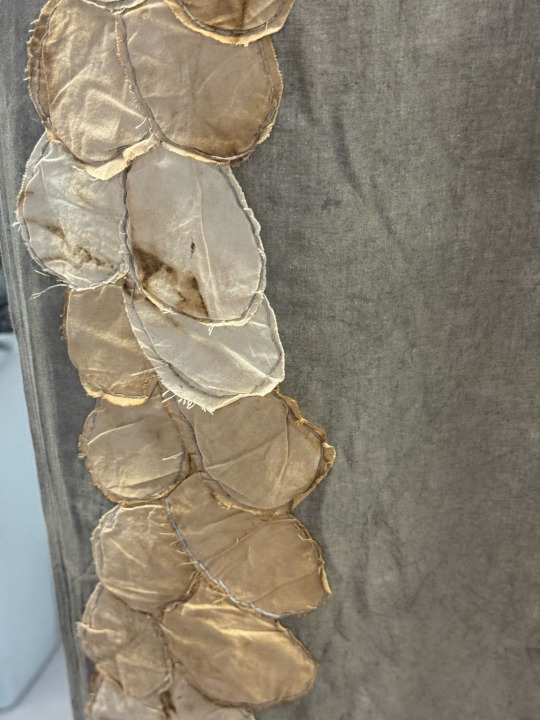
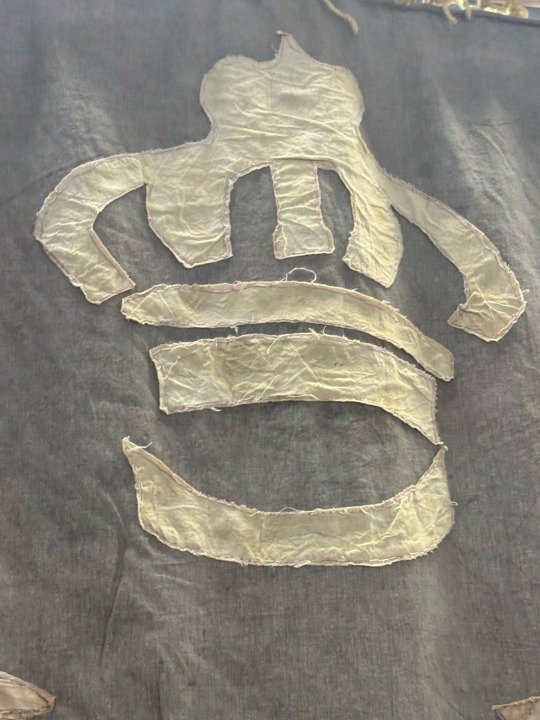
My fiber arts final! This is what I was working on instead of any of my normal illustration. It’s a Torah ark cover— a parochet— and it’s meant to commemorate the Simchat Torah Pogrom. The bit in the middle is a supernova, while the bits at the sides are meant to be either grain or challah, representing the kibbutzim. The Hebrew reads “We will dance again,” in reference to Mia Schem. All naturally dyed. Anyone clowning in the notes will be immediately blocked.
IMAGE ID: A series of photographs of a curtain hung in front of a wall. The curtain has a grey background and a number of appliqué pieces sewn on with embroidery floss. In the center is the image of a supernova and it’s framed by pillars of wheat like brown leaves on each side. On the top is a yellow crown, while on the bottom is the Hebrew: עוד נרקוד שוב. The Hebrew lettering is in pink and is attached with a pale yellow satin stitch. The first photograph is of the entire piece, while the other three are detail shots of the supernova, the wheat, and the crown. END ID.
#my art#sewing#embroidery#appliqué#judaica#parochet#October 7#jumblr#Jewish#simchat torah pogrom#am yisrael chai#fiber arts#natural dye
50 notes
·
View notes
Text
HaKodesh Kadosh (Take me to Shul)
nsfw, religious imagery, ~1500 words
It was his brother’s bar mitzvah. His mother was absolutely livid when we walked in a half hour after shacharit had already started. She couldn’t chew us out since she was sitting at the front of the room, closest to the bimah, so she settled on giving us death stares. We both grabbed siddurs and he grabbed a kippah before we both went our separate ways, on opposite sides of the mechitza.
It didn't really matter to me which side of the mechitza I sat on, but I chose the women’s side that day to try to allay his mother’s fears of us disrupting the service after the transgression of coming in late.
I picked a seat all the way in the back. It wasn’t that I didn’t want to show support for the bar mitzvah boy and his family, it’s just that sometimes the rabbi can go on for a long time, and I want to be able to pull out my book without judgment.
Today, though, I was feeling rather spiritual. I abandoned my book in the siddur holder attached to the back of the seats in front of me and stood with the congregation. I said kaddish with them and sang along as they took the torah out of the aron and paraded it around the sanctuary. They even brought it all the way to where I was sitting so I could plant a little kiss on it.
I kept my eye on the person carrying the torah as they took it up to the bimah. They started to undress it, removing the cloth cover, velcro band, and adornments that kept it safe while it sat in the aron, waiting to be used.
“I wish that could be us,” said a voice from the other side of the mechitza. I didn’t have to pull the curtain aside to know that it was him.
“Are you serious? Right now?” I hissed. If it was any other situation I’d be inclined to humor him. But this felt a little sacrilegious.
“Oh come on, I know you’re thinking it too. Plus, he’ll become a man whether I’m here or not, we may as well have a little fun while we’re here.”
I said a silent prayer for forgiveness and reminded myself that sex is technically a mitzvah.
I closed my siddur, put it in the holder attached to the seat in front of me, and slipped my hand behind the mechitza. His hand met mine and he interlocked our fingers. He brushed his thumb over the back of my hand for a minute, testing the waters.
I heard the sound of fabric against drywall in addition to the feeling of his weight shifting. I realized he’d moved from his seat to the floor and I followed suit. As soon as I got comfortable he got bolder. He moved our hands from his side to my side, and he rested them on my thigh.
He unclasped our hands and placed his palm on my leg. He didn’t stop the rubbing of his thumb, moving it from the back of my hand to my inner thigh. They had finished undressing the torah by now and had already called up some family member for the first aliyah.
As the bracha was read, his hand climbed higher and higher until it rested just before my most sensitive spot. I let out a shaky breath before placing my hand over his, guiding it onward.
“Amein,” the crowd sang out, and he sang it with them as he expertly slipped his hand under my clothes. I stifled a gasp as he ran his fingers through my pubic hair. I peered behind the mechitza and saw him looking dead ahead. He was playing the part of the perfect older brother, the good Jewish boy. But for a moment, he glanced over at me and flashed a sultry grin. I prayed the sound of crinkling candy wrappers would mask whatever noises I made.
After a few minutes he got bolder, moving his fingers so that they brushed against my sex. He worked them back and forth, with varying pressure, knowing just how to push my buttons and make me groan. He kept going, through the second and third aliyah, at a lazy pace, ignoring my hushed requests for him to speed up.
Then, all of a sudden, he stopped. I looked over and he got up almost mechanically, taking out a travel pack of kleenex and wiping his hands on it. I watched as he walked up to the bimah and put on a tallit. I mentally smacked myself. Of course he was reading from the torah. He’s the bar mitzvah boy’s brother. I saw him adjust his kippah and take the yad in his hand. Some people I didn’t recognize stood beside him and said the bracha, and then he began to read.
I tried to follow along in a chumash, but I couldn’t. I was still so distracted by his touch. I could feel the pulsing arousal in my core and I couldn’t ignore it. Eventually I worked up the courage to bring myself to the front of the sanctuary; to sit next to the bimah. I brought my chumash with me and I sat myself down right near where he was standing. He couldn’t see me yet, he was too focused on reading, but when he was done, he looked around and caught my eye. He came around to the right side of the table where the torah was being held, holding my gaze the entire time. I wondered if he was going to bend down and say something to me, when I noticed his hands were moving. He gestured to me, then to him, and then to the aron. I cocked my head at him. He wasn’t seriously suggesting…?
Before I could clarify his attention was taken by the chazzan, who was asking him to recite a bracha. Only two more aliyot before he would be able to sit down with me again.
Or so I thought. I had forgotten that the rabbi enjoyed speaking at length to the celebrating family. He was stuck up there for what felt like a million years. The rabbi droned on and on about community and adulthood and whatnot before finally giving the family a little baggie full of assorted judaica. I caught his eye one last time before he sat down next to his brother. He mouthed something to me, which looked a lot like “meet me behind the aron” before turning to face the front of the room, acting as if nothing had happened.
I sat on my hands all throughout musaf, trying to keep my mind on the prayers instead of where it wanted to go. I forced myself to say the words of the kaddish in earnest and I tried my best to follow along through the recitation of the amidah. But the end of the service couldn’t come fast enough. When the rabbi finally said the bracha over the wine, it took everything in my power to not race up to the bimah.
As calmly as I could, I ascended the small steps and looked around for him. I didn’t see him at first, but then I heard a hiss from behind me.
“Over here!”
I turned around to see a hand poking out from behind the aron. Inconspicuously, I went around the side to find that there was a small crawl space behind the aron that I had never known about, and that he had discovered. He beckoned me inside and I gladly took his invitation.
Neither of us wasted any time on pleasantries. We were both too worked up. He quickly slipped his fingers under my clothes once more and I took this opportunity to finally kiss him. I kissed him long and hard, moaning into his mouth as he worked his magic, flooding my senses with pure arousal. I bucked my hips, grinding into his hand, and he laughed softly.
“You’re so worked up,” he whispered. “Maybe we should come here every week.”
I didn’t know if the pun had been intended, but even if it wasn’t he sped up his handiwork. I knew I wasn’t going to last much longer, and I tried to warn him. He simply shushed me and enveloped my mouth in another kiss. I continued to muffle breathy moans into his mouth as he pushed me over the edge and helped me through the aftermath.
Afterward I wanted to fall limp, like a puppet whose strings had been cut. I hadn’t realized how much energy I had devoted to this, but now that I had lost it I just wanted to fall asleep. He beckoned me closer and pulled my head onto his lap.
“Don’t worry about falling asleep,” he reassured me. “Everyone’ll be back for seudat shlishit. They won’t even know we’re gone. His words calmed my nerves, and I was able to fall into an easy doze.
17 notes
·
View notes
Text

What the Hell?
Judaism does not have a specific doctrine about the afterlife, but it does have a mystical/Orthodox tradition of describing Gehinnom. Gehinnom is not hell, but originally a grave and in later times a sort of Purgatory where one is judged based on one's life's deeds, or rather, where one becomes fully aware of one's own shortcomings and negative actions during one's life.
The Kabbalah explains it as a "waiting room" (commonly translated as an "entry way") for all souls (not just the wicked). The overwhelming majority of rabbinic thought maintains that people are not in Gehinnom forever; the longest that one can be there is said to be 12 months, however, there has been the occasional noted exception. Some consider it a spiritual forge where the soul is purified for its eventual ascent to Olam Habah (heb. עולם הבא; lit. "The world to come", often viewed as analogous to heaven). This is also mentioned in the Kabbalah, where the soul is described as breaking, like the flame of a candle lighting another: the part of the soul that ascends being pure and the "unfinished" piece being reborn.
According to Jewish teachings, hell is not entirely physical; rather, it can be compared to a very intense feeling of shame. People are ashamed of their misdeeds and this constitutes suffering which makes up for the bad deeds. When one has so deviated from the will of God, one is said to be in Gehinnom. This is not meant to refer to some point in the future, but to the very present moment. The gates of teshuva (return) are said to be always open, and so one can align his will with that of God at any moment. Being out of alignment with God's will is itself a punishment according to the Torah.
Many scholars of Jewish mysticism, particularly of the Kabbalah, describe seven "compartments" or "habitations" of hell, just as they describe seven divisions of heaven. These divisions go by many different names, and the most frequently mentioned are as follows:
Sheol (Hebrew: שְׁאוֹל – "underworld", "Hades"; "grave")
Abaddon (Hebrew: אֲבַדּוֹן – "doom", "perdition")
Be'er Shachat (Hebrew: בְּאֵר שַׁחַת, Be'er Shachath – "pit of corruption")
Tit ha-Yaven (Hebrew: טִיט הַיָוֵן – "clinging mud")
Sha'are Mavet (Hebrew: שַׁעֲרֵי מָוֶת, Sha'arei Maveth – "gates of death")
Tzalmavet (Hebrew: צַלמָוֶת, Tsalmaveth – "shadow of death")
Gehinnom (Hebrew: גֵיהִנוֹם, Gehinnom – "valley of Hinnom"; "Tartarus", "Purgatory")
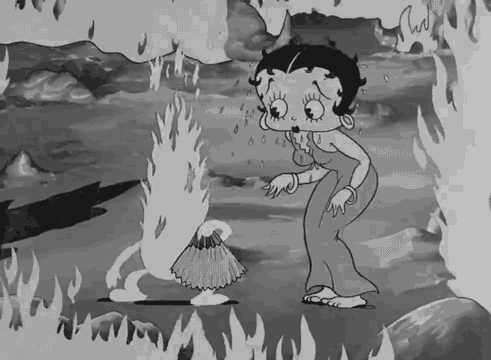
Besides those mentioned above, there also exist additional terms that have been often used to either refer to hell in general or to some region of the underworld:
Azazel (Hebrew: עֲזָאזֵל, compd. of ez עֵז: "goat" + azal אָזַל: "to go away" – "goat of departure", "scapegoat"; "entire removal", "damnation")
Dudael (Hebrew: דּוּדָאֵל – lit. "cauldron of God")
Tehom (Hebrew: תְהוֹם – "abyss"; "sea", "deep ocean")
Tophet (Hebrew: תֹּפֶת or תוֹפֶת, Topheth – "fire-place", "place of burning", "place to be spit upon"; "inferno")
Tzoah Rotachat (Hebrew: צוֹאָה רוֹתֵחַת, Tsoah Rothachath – "boiling excrement")
Mashchit (Hebrew: מַשְׁחִית, Mashchith – "destruction", "ruin")
Dumah (Hebrew: דוּמָה – "silence")
Neshiyyah (Hebrew: נְשִׁיָּה – "oblivion", "Limbo")
Bor Shaon (Hebrew: בּוֹר שָׁאוֹן – "cistern of sound")
Eretz Tachtit (Hebrew: אֶרֶץ תַּחְתִּית, Erets Tachtith – "lowest earth").
Masak Mavdil (Hebrew: מָסָך מַבְדִּ֔יל, Masak Mabdil – "dividing curtain")
Haguel (Ethiopic: ሀጉለ – "(place of) destruction", "loss", "waste")
Ikisat (Ethiopic: አክይስት – "serpents", "dragons"; "place of future punishment")
Maimonides declares in his 13 principles of faith that the hells of the rabbinic literature were pedagogically motivated inventions to encourage respect of the Torah commandments by mankind, which had been regarded as immature. Instead of being sent to hell, the souls of the wicked would actually get annihilated.

13 notes
·
View notes
Photo

Velvet Torah ark curtain, Budapest, 1872
Center for Jewish Art (via shvlman)
93 notes
·
View notes
Text

gevurah b'netzach, for my mishpocha who are counting with me… Thank you so much for supporting my work!
patreon.com/kimchicuddles
The Omer is counted every nightfall starting the 2nd night of Passover until the night before Shavuot (marking when we received the Torah). This yearly cycle of counting lasts 49 days and every nightfall has its own opportunity for reflection. Each of the 7 weeks has its own focus and each of the 7 days within each week has its own focus within that focus. During Sefirat Ha'Omer, we are invited on a mystical journey, a journey that spirals us deeper and deeper into discovering what exists within our psyches and souls…
text reads:
gevurah b'netzach (discernment and strength within endurance)
During childbirth, I needed a kind of endurance that I'd never needed before.
What brought me the ability to keep going was the discernment
in knowing what to focus my energy and attention on.
The intensity of the moment brought me into a sort of hyperfocus of my surroundings,
and in every milli-second when I felt the pain becoming unbearable again
I shifted focus onto a new object and named it in my mind...
"yellow chair... blue curtain... white ceiling"
This gave me the inner strength to keep going a moment longer.
And because I went through that I have a feeling like I can go through anything.
When I become overwhelmed, I can notice the objects in the room I'm in,
and it snaps me back into remembering who I am and what I'm capable of.
#countingtheomer #gevurah #netzach #kabbalah #sefirot #jewish
8 notes
·
View notes
Text

Torah ark curtain by Simhah, wife of Menahem Levi Meshullami.
From Venice, 1680/81. Embroidered with silk and metallic thread; metallic fringe. 216.1 × 140.1 cm.
This is an extraordinary Torah curtain because of its impressive size, beautiful workmanship, and unusual iconography. The dedication at the bottom reaffirms the significant role played by Italian Jewish women in the creation of synagogue textiles, even among very wealthy and prominent families such as the Meshullami, one of the first Jewish families to settle in Venice.
What is unusual is the detailed representation of Jerusalem, unique in Torah curtain iconography, but common on another type of seventeenth-century Italian Judaica, decorated ketubbot. Since the Italian Jewish marriage ceremony includes the recitation of Psalm 128, which mentions Jerusalem, and remembrances of the city's destruction conclude every Jewish wedding, depictions of the city were appropriate to the decoration of the contracts displayed at the ceremony, creating an iconographic link between two forms of Judaica prominent in the lives of women.
#jumblr#judaism#judaica#jewish textile arts#torah curtain#italy#simhah meshullami#myposts#jewish women
192 notes
·
View notes
Text



An Important Jeweled American Torah Shield, Circa, 1910
This stunning Torah shield is a true work of art. The main decoration is an imitation of the breastplate worn by the High Priest in the Temple in Jerusalem, where twelve stones are placed for each of The Twelve Tribes. Here under each stone, the tribe name in Hebrew is expertly engraved.
Hallmarked "Millwood Sterling Silver".
The maker of this shield, "Millwood", was a jewelry firm in New York City until 1915. The shield was designed and decorated in the way Edwardian jewelry at the times was; a mixture of Art Nouveau elements, such as the leaves and colorful stone encrusted grape clusters seen at the top, along with more formal designs from the Neo-Classical era such as curtains/swags and ancient columns. Continuing underneath each base of four columns is the last point of Edwardian-style decoration; large stars filled with stones in an angular "royal" shape, as if it were a badge worn by a king. Underneath the base of the center column is a lengthy dedication in Hebrew, indicating it was a gift to the synagogue it was presented to.
What cannot be appreciated from photos alone is the amount of workmanship that went into creating this shield. All of the leaves seen at top, the large, bold Hebrew lettering above the crown stating "Holy to Hashem", is in repousse, that is, hand hammered from the reverse side. There is also a tremendous amount of "matting" on the shield, noticeable on the curtains and the space above it, this gives the effect of the shield moving, as it has texture. Notice how this shield was not entirely covered in gold-wash / gilt, but the gilding was only placed on some of the leaves and the drapes at the outer columns; this makes for a lively contrast with the rest of the silver color. Finally we have a crown directly below "Holy to Hashem". This crown, by itself, could be an exquisite piece of jewelry. The design of the crown and choice of alternating reddish-purple and clear stones is something straight out of a portrait of a Maharaja in India.
This Torah shield was not made by a silversmith; it was made by a jewelry firm, which is why it is so visually appealing, as fine jewelry is meant to draw the eye in. There is a built in hook on the reverse with loops so this shield can fit extra securely, locked into the staves of the Torah scroll itself.
We believe this is the most beautiful Torah shield ever created in the United States of America. We cannot understate it's importance regarding the history of Jews in America. This is most assuredly a one of a kind, specially commissioned piece that at the time, cost a very large sum.
Appel Auctions
40 notes
·
View notes
Text

Torah ark curtain, Tehran (Teheran), Iran, 1952
451 notes
·
View notes
Text
Some people have asked me why I believe the Ark of the Covenant is an electrostatic device, and I would encourage them to look into the work of Maurice Denis-Papin, who was a descendant of the famous inventor, and who determined that the Ark was capable of holding 500-700 volts per vertical meter when contained in a dry space, dischargeable to the earth by means of it's garlands- and this is even before it has a superconductive substance in it like monoatomic atoms (manna), and before it is placed in something like the Great Pyramid, which has its own electrostatic potential. I would also point out Bruce Rux's research in his book Architect of the Underworld, where he mentions:
"The story of the flood is the conclusion of one of those mythical, epic conflicts. There were others. Sitchen pieces together the story of two civil wars in his work, "The Pyramid Wars", taken largely from the Sumerian "Myths of Kur" tablets, the Lugal-e epic, F.Hrozny's "Mythen von dem Gotte Ninib", J.Bollenrucher's "Gebete und Hymnen an Nergal", and George A. Barton's "Miscellaneous Babylonian Texts", as well as fragmentary tablets from the region. These texts constitue strong evidence for the two Great Pyramids at Giza having been in existence long before Egyptology claims they were. A cylinder seal shows the symbol of Ninurta (Horus) with a victory wreath, between two objects which could only be pyramids- not only are they triangles, bit they are composed of tiers of rectangular blocks. Reference to one of these is given as "the mountains the gods assembled". Inside it were lethal "stones" , with which "the Great Serpent" nearly killed Ninurta in his battle against (the serpent), with their "strong power". ..to "grab and kill, with a tracking which seizes". The "stones" glowed in the dark in different colors, set in various recesses which may be found in the Great Pyramid....one of the weapons was a net, the device of which was located in a secret chamber in the Pyramid." It should also be pointed out that the ancient name of the Sphynx is ARQ UR, possibly related to where the name "Ark" itself came from...
Now even if such an Ark wasn't placed in the Great Pyramid, but instead was placed in a tabernacle in the dessert with WOOL curtains, which, of course, pick up static on their own, then what do you think the Ark would do inside that location? It would just absorb more static electricity of course, until it began to discharge out of the top- as the "presence of God!" Our Order has found six arks, and we know where there is another four, and it is possible that there were hundreds in the ancient world before they got melted down for the previous metals... This reasonably suggests that they were being used for that electrostatic potential in different ways. They are depicted all over the Egyptian temple walls...yet people only think of the Torah or Old Testament when discussing it...
4 notes
·
View notes
Text

THIS WEEK'S TORAH PORTION
Parashat Terumah: Exodus 25:1 - 27:19
In this Torah portion, Moses receives God’s commandments on stone tablets. God tells Moses to create a dwelling place for God, where the Israelites can bring God gifts. God details what this Mishkan (Tabernacle) will look like and how it should be made. The Tabernacle includes an ark, two cherubs, curtains and a menorah.
MORE TORAH
6 notes
·
View notes